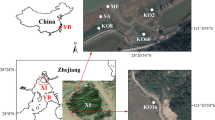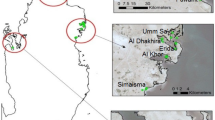Abstract
Recolonization of epibiotic flora and fauna in two fringing Sonneratia alba reforestation plots was investigated and compared to a natural mangrove stand and a denuded site in Gazi Bay, Kenya. The reforested sites differed with respect to land history and planting density. Habitat availability in the form of pneumatophore surface differed among forested sites (P<0.001), and between landward and seaward zones (P<0.05). Eighteen algal species were found in the natural area compared to 23 and 10 in replanted sites. Only one species was encountered in the denuded area. SIMPER analysis distinguished Enteromorpha ramulosa, Polysiphonia sp., Hypnea sp. and Caloglossa leprieuri as the main algal species responsible for differences between sites. Algal biomass was positively correlated to pneumatophores area (P<0.001). Total algal biomass differed markedly between forested sites: 1.4 (matrix replantation), 28.6 (natural stand) and 44.3 g m−2 (integrated replantation) in the seaward zones. The matrix replantation showed strong differences in algal community assemblages compared to the other forested sites, and this site also had significantly lower biomass of sessile benthic fauna (P<0.001). Statistical differences in algal (P<0.01) and sponge (P<0.05) community composition between landward and seaward zones were observed in all sites and trunk fouling fauna was distinctly different between sites. Reasons for the above patterns are discussed and it is suggested that zonation patterns affecting pneumatophore surface and inundation time, in combination with proximity of sites to natural seeding areas, are the most likely explanations for observed patterns of epibiotic community distribution in this study.
Similar content being viewed by others
References
Alvarez B, Diaz MC, Laughlin RA (1990) The sponge fauna on a fringing coral reef in Venezuela, I. Composition, distribution and abundance. In: Rützler K (eds) New perspectives in sponge biology. Smithsonian Institution Press, Washington DC, pp 358–366
Barthel D, Tendal OS (1993) The sponge association of the abyssal Norwegian Greenland Sea: species composition, substrate relationships and distributions. Sarsia 78:83–96
Bayliss DE (1993) Spatial distribution of Balanus amphitrite and Elminius adelaide on mangrove pneumatophores. Mar Biol 116:251–256
Beanland WR, Woelkerling WmJ (1983) Avicennia canopy effects on mangrove algal communities in Spencer Gulf, South Australia. Aquat Bot 17:309–313
Beck MW (2000) Separating the elements of habitat structure: independent effects of habitat complexity and structural components on rocky intertidal gastropods. J Exp Mar Biol Ecol 249:29–49
Bell JJ, Barnes KA (2003) Effect of disturbance on assemblages:an example using porifera. Biol Bull 205:144–159
Bingham BL, Young CM (1991) Larval behaviour of the ascidian Ecteinascidia turbinata Herdman; an in situ experimental study of the effects of swimming on dispersal. J Exp Mar Biol Ecol 145:189–204
Bingham BL, Young CM (1995) Stochastic events and dynamics of a mangrove root epifaunal community. Mar Ecol 16(2):145–163
Burkholder PR, Almodovar LR (1974) Studies on mangrove algal communities in Puerto Rico. Florida Sci 36:66–73
Cheshire AC, Wilkinson CR (1991) Modeling the photosynthetic production by sponges on Davis Reef, Great Barrier Reef. Mar Biol 109:13–18
Clarke KR (1993) Non-parametric multivariate analyses of changes in community structure. Aust J Ecol 18:117–143
Clarke KR, Green RH (1988) Statistical design and analysis for a ‘biological effects’ study. Mar Ecol Progress Ser 46:213–226
Clarke KR, Warwick RM (2001) Change in marine communities: An approach to statistical analysis and interpretation, 2nd edn. Primer-E, Plymouth
Coates M, McKillup SC (1995) Role of recruitment and growth in determining the upper limit of distribution of the intertidal barnacle Hexaminus popeiana. Marine and Freshwater Research 46:1065–1070
Crona BI, Rönnbäck P (2005) Utilization of replanted mangroves as nursery ground for shrimp communitites in Gazi Bay, Kenya. Estuarine Coastal Shelf Sci 65:535–544
Davey A, Woelkerling WmJ (1985) Studies on Australian mangrove algae. III. Victorian communities: structure and recolonization in western Port Bay. J Exp Mar Biol Ecol 85:177–190
Davis AR, Butler AJ (1989) Direct observations of larval dispersal in the colonial ascidian Podoclavella moluccensis Sluiter: evidence for closed populations. Exp Mar Biol 127:189–203
de Troch M, Mees J, Wakwabi E (1998) Diets of abundant fishes from beach seine catches in seagrass beds of a tropical bay (Gazi Bay, Kenya). Belgian J Zool 128(2):135–154
Dunlap M, Pawlik JR (1996) Video-monitored predation by Caribbean reef fishes on an array of mangrove and reef sponges. Mar Biol 126:117–123
Ellison AM, Farnsworth EJ (1990) The ecology of Belizean mangrove-root fouling communities: I. Epibenthic fauna are barriers to isopod attack of red mangrove roots. J Exp Mar Biol Ecol 142:91–104
Ellison AM, Farnsworth EJ (1992) The ecology of Belizean mangrove-root fouling communities: patterns of distribution and abundance and effects on root growth. Hydrobiologia 247:87–98
Ellison AM, Farnsworth EJ, Twilley RR (1996) Facultative mutualism between red mangrove and root-fouling sponges in Belizean mangal. Ecology 77(8):2431–2444
Ellison AM (2000) Mangrove Restoration: Do we know enough? Restor Ecol 8(3):219–229
Eston VR, Braga MR, Cordeiro-Marino M, Fujii MT, Yokoya NS (1992) Macroalgal colonization patterns on artificial substrates inside southeastern Brazilian mangroves. Aquat Bot 42(4):315–325
Farnsworth EJ, Ellison AM (1996) Scale-dependent and temporal variability in biogeography of mangrove root epibiont communities. Ecol Monogr 66(1):45–66
Field CD (eds) (1996) Restoration of mangrove ecosystems. International Society for Mangrove Ecosystems, Okinawa, Japan, pp 250
Field JG, Clarke KR, Warwick RM (1982) A practical strategy for analyzing multispecies distribution patterns. Mar Ecol Progress Ser 8:37–52
Grosberg RK (1982) Intertidal zonation of barnacles: the influence of planktonic zonation of larvae on vertical distribution of adults. Ecology 63:894–899
Imbert D, Rousteau A, Scherrer P (2000) Ecology of mangrove growth and recovery in Lesser Antilles: State of knowledge and basis for restoration projects. Restor Ecol 8(3):230–236
Jaasund E (1976) A field guide to the intertidal seaweeds in Tanzania, 1st ed. University of Tromsö, Norway
Kairo JG (1995) Community participatory forestry for the␣rehabilitation of deforested mangrove areas of Gazi Bay Kenya. A first approach. Final technical report. BSP/WWF-(USA) and University of Nairobi (Botany Department)
Kairo JG, Dahdouh-Guebas F, Bosire J, Koedam N (2001) Restoration and management of mangrove systems – a lesson for and from the East African region. South Afr J Bot 67(3):383–389
Kitheka JU (1997) Coastal tidally-driven circulation and the role of water exchange in the linkage between tropical coastal ecosystems. Estuarine Coastal Shelf Sci 45:177–187
Lindén O, Lundin CG (1996) Integrated coastal zone management in Tanzania. World Bank, Environmental Department and Sida, Department of Research Cooperation/SAREC, Sweden, pp 166
Maldonado M, Young C (1996) Effects of physical factors on larval behavior, settlement and recruitment of four tropical demosponges. Mar Ecol Progress Ser 138:169–180
Mwashote BM, Jumba IO (2002) Quantitative aspects of nutrient fluxes in the Gazi Bay (Kenya): implications for coastal ecosystems. Mar Pollut Bull 44(11):1194–1205
Oliveira EC, Österlund K, Mtolera MSP (2005) Marine plants of Tanzania. In: Sporrong N, BjÖrk M (eds) A field guide to the seaweeds and seagrasses. Botany Dept., Stockholm University, Sweden, pp 267
Osman RW (1977) The establishment and development of a marine epifaunal community. Ecol Monogr 47(1):37–63
Procheş ş, Marshall K, Ugrasen K, Ramcharan A (2001) Mangrove pneumatophore arthropod assemblages and temporal patterns. J Mar Biol Assoc UK 81:545–552
Randall JE, Hartman WD (1968) Sponge-feeding fishes of the West Indies. Mar Biol 1:216–225
Rice WR (1989) Analyzing tables of statistical sets. Evolution 43:223–225
Richmond MD (ed) (1997) A guide to the seashores of East Africa and the Western Indian Ocean Islands. Sida-SAREC Stockholm, pp 448
Rodrigues C, Stoner AW (1990) The epiphyte community of mangrove roots in a tropical estuary: distribution and biomass. Aquat Bot 36:117–126
Satumanatpan S, Keough M, Watson GF (1999) Role of settlement in determining the distribution and abundance of barnacles in a temperate mangrove forest. J Exp Mar Biol Ecol 241:45–66
Satumanatpan S, Keough M (2001) Roles of larval supply and behavior in determining settlement of barnacles in a temperate mangrove forest. J Exp Mar Biol Ecol 260:133–153
Steneck RS, Dethier LE (1994) A functional group approach to the structure of algal-dominated communities. Oikos 69:476–498
Sutherland JP (1980) Dynamics of the epibenthic community on roots of the mangrove Rhizophora mangle, at Bahía de Buche, Venezuela. Mar Biol 58:75–84
Warwick RM, Clarke KR, Suharsono (1990) A statistical analysis of coral community responses to the 1982–3 El␣Niño in the Thousand Islands, Indonesia. Coral Reefs 8:171–179
Watson JG (1928) Mangrove forests of the Malay Peninsula, vol. 6. Malay Forest Records, 275 pp
Acknowledgements
This study was funded by the Swedish International Development Agency (Sida). The authors thank the Kenya Marine and Fisheries Research Institute (KMFRI) for logistical support. A special thank you goes to J. Bosire and J.␣Kairo for assistance in Kenya, to Abdul for tireless field assistance, to Nils and Lena Kautsky for valuable comments and help with taxonomic identification, and to two anonymous reviewers for helpful comments on how to improve the manuscript.
Author information
Authors and Affiliations
Corresponding author
Rights and permissions
About this article
Cite this article
Crona, B., Holmgren, S. & Rönnbäck, P. Re-establishment of epibiotic communities in reforested mangroves of Gazi Bay, Kenya. Wetlands Ecol Manage 14, 527–538 (2006). https://doi.org/10.1007/s11273-006-9005-7
Received:
Accepted:
Published:
Issue Date:
DOI: https://doi.org/10.1007/s11273-006-9005-7




